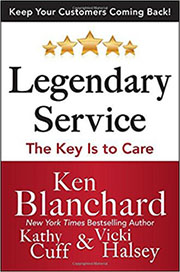 Studies by the Hay Group, Aon Hewitt, Towers Watson, Gallup, and other consulting firms have clearly established the important role leaders play in an employee’s well-being, engagement, and performance.
Studies by the Hay Group, Aon Hewitt, Towers Watson, Gallup, and other consulting firms have clearly established the important role leaders play in an employee’s well-being, engagement, and performance.
In its own research into employee work passion, The Ken Blanchard Companies has found significant correlations between perceptions of leader behavior, employee affect, and subsequent intentions to stay with a company, endorse the organization as a good place to work, and perform at a high level.
So why don’t more organizations invest in developing their leaders? What keeps them from taking steps in the right direction?
“For a lot of organizations, it’s just not part of their founding DNA,” says consultant and author Scott Blanchard in the latest issue of Ignite. “Some companies don’t grow up with it.”
That can be a challenge for managers and individuals looking to grow and develop within those cultures. People who want to develop and grow will find themselves plateauing or hitting the wall early without a clear process for developing themselves and others.
For leaders looking to take some steps toward reinvigorating themselves and others, Blanchard recommends four areas to focus on—understanding yourself, building relationships, producing results, and charting careers.
Step 1. Understanding Yourself
Great leaders begin with a profound understanding of themselves. But Blanchard cautions that in order to get an accurate picture of yourself, you have to get input from others. Self-understanding can’t happen in a vacuum.
“The best leaders do 360s so they can compare their self-perception to the perception of people around them. Inevitably, poor leaders are ones who either don’t care or who have an inaccurate awareness of the way they’re coming across to others. And that’s what Dilbert and the pointy-haired boss are all about. Don’t be that guy. Nobody wants to be that guy.”
Step 2. Building Relationships
As a next step, Blanchard recommends developing and constantly improving your skill in building relationships with people. If there’s one thing to remember, it’s that fundamentally, the art of building relationships centers on serving people.
In Blanchard’s experience, the reason this is so important is the different way that people perceive the actions of leaders who are focused on others instead of solely focused on their own agenda. When people perceive that their leader is coming from the right place and then buy in to that person, they feel safe, they forgive a leader’s mistakes, and they are more willing to put themselves out, try a little harder, and achieve more.
Step 3. Producing Results
The first two steps set the foundation that allow a leader to push people toward better performance. The third step is to learn how to work together with others with the explicit intention of generating better results. And it is not in a manipulative way explains Blanchard. “Leadership is something you do with people—partnering with them in the accomplishment of goals—it’s not something you do to them.
“You’re looking to leverage that interpersonal capacity to produce better results. Great people want to perform at a high level. A leader’s job is to help them get there.”
Step 4. Charting Careers
In today’s work environment the opportunity to grow is more important than ever before. Growth is the currency of this new economy. People recognize that their ability to grow and learn new things is what keeps them valuable. In this fourth and final step, you—as a leader—must ensure that this is a part of your skill set.
Your goal as a leader is to let them know that you are a partner in their career journey,” says Blanchard. “It’s finding ways that people can grow by giving them a chance to excel in their present job but also looking at what you can do to provide them with opportunities for the next leg of their career.”
It’s a journey that begins with a better understanding of yourself and then expands to include a better understanding of others and how to work together to achieve common goals. This will result in benefits for both the individual and the organization.
To learn about Blanchard’s approach check out Developing Yourself and Others , or join Blanchard for a free webinar on March 19, Leading Yourself and Others to Higher Levels of Performance: A Four-Fold Approach

Read more http://leaderchat.org/2014/03/13/four-steps-to-developing-yourself-and-others-2/






